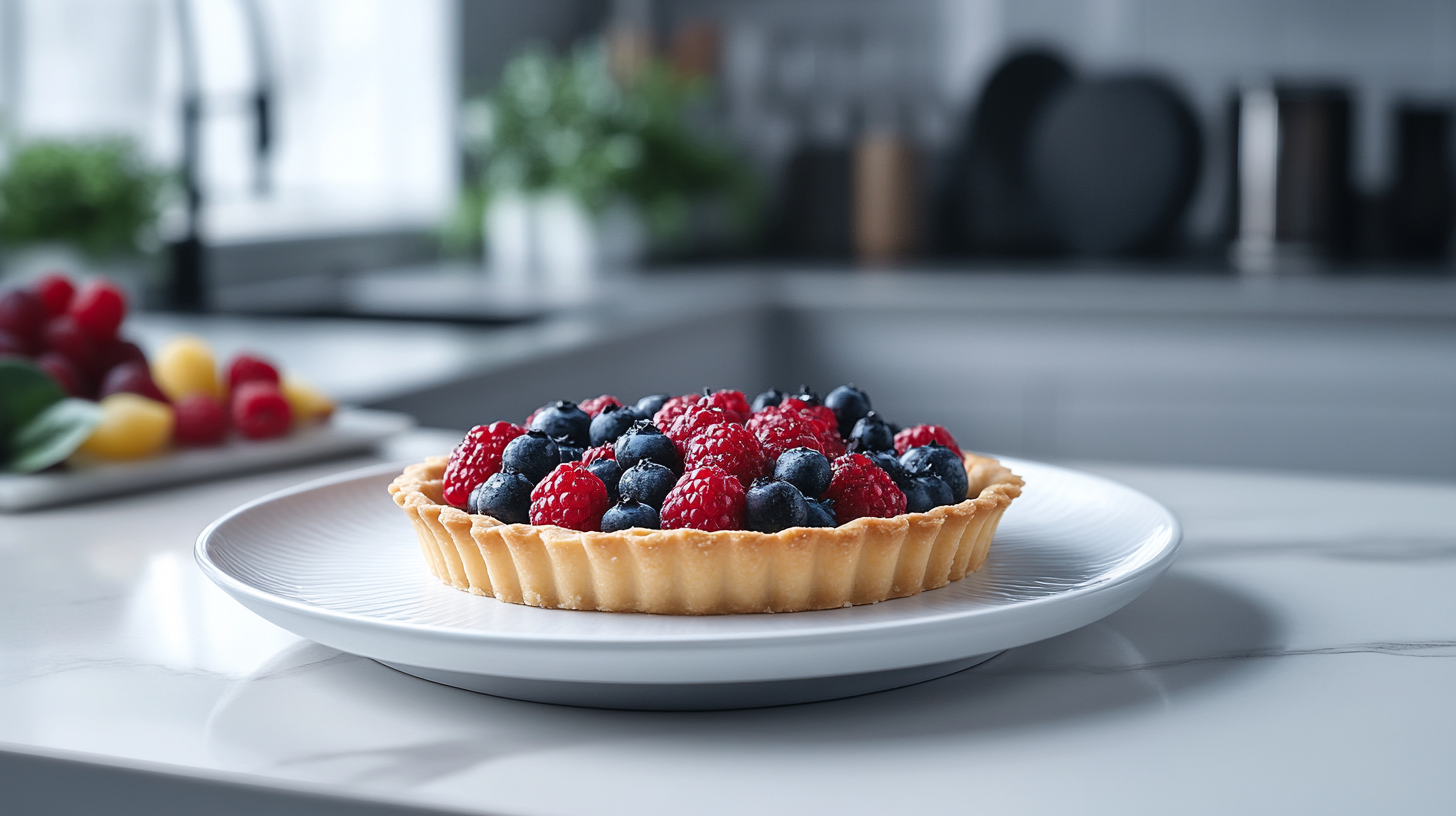Introduction to Fruit Tarts
Fruit tarts are not just a treat for the palate—they’re also a feast for the eyes. Their combination of crisp crusts, creamy fillings, and vibrant fruits makes them a show-stopping dessert for any occasion. Moreover, these desserts can be tailored to suit a variety of flavors and preferences, making them versatile and fun to create. Whether you’re a seasoned baker or someone who enjoys occasional baking experiments, mastering the art of fruit tarts is both a rewarding and achievable goal.
For those beginning their tart journey, a reliable shortbread crust recipe provides an essential foundation. Additionally, the filling, often a luscious pastry cream, can elevate your tart to a professional level when mastered using this silky pastry cream guide. These two components are the backbone of most successful tarts.
Types of Fruit Tarts
There’s a fruit tart for every occasion, and knowing your options ensures you can pick the right one. While some tarts follow traditional recipes, others allow for more creative freedom. Here are some of the most popular types:
- Classic French Tart: Features a baked crust, rich pastry cream, and neatly arranged fresh fruits. This timeless choice is a staple in patisseries worldwide.
- Mini Tartlets: Perfect for individual servings at parties and gatherings, these small-sized tarts are both convenient and visually appealing.
- Rustic Galettes: A freeform tart with a charming, rustic aesthetic, ideal for bakers who prefer a less structured approach.
- No-Bake Variations: These quick and easy tarts are made with a graham cracker crust and whipped fillings, making them perfect for last-minute desserts.
- Diet-Friendly Tarts: Vegan and gluten-free options cater to dietary needs while still delivering delicious flavors.
Each of these tarts can be customized with different fillings, fruits, and glazes, offering endless possibilities. For a similar dessert idea, consider cheesecake bars, which are equally versatile and ideal for special occasions. In fact, serving cheesecake bars alongside fruit tarts creates a delightful dessert spread.
Key Components of Fruit Tarts
A perfect fruit tart is a harmonious blend of its core elements. Therefore, focusing on these components is essential for success:
1. The Crust
The crust provides the base for your tart. While shortbread is the most common choice for its buttery flavor and crisp texture, you can also use puff pastry for a lighter feel or a graham cracker crust for no-bake versions. Each type of crust contributes a unique texture and taste, so choosing the right one depends on your desired outcome.
Pro Tip: Pre-bake (blind bake) your crust to avoid sogginess. Additionally, adding a layer of melted chocolate or jam between the crust and filling helps maintain its crispness over time.
2. The Filling
The classic choice for filling is pastry cream, which is made with milk, sugar, and cornstarch. This rich and velvety custard pairs beautifully with fresh fruits. For lighter options, you can try whipped mascarpone, cream cheese, or even a flavored yogurt base for a healthier alternative.
To explore more about creative fillings, check how to fill cupcakes with cream for ideas that can inspire unique tart variations.
3. The Fruits
Your choice of fruits should balance sweetness and acidity. Furthermore, the fruits should be fresh and vibrant for the best results. Popular options include:
- Berries: Blueberries, raspberries, and strawberries are favorites for their bright colors and tangy flavors.
- Tropical Options: Mango, kiwi, and pineapple add an exotic twist that pairs well with creamy fillings.
- Seasonal Picks: Stone fruits like peaches, plums, and apricots offer a sweet, juicy burst of flavor.
When arranging fruits, consider patterns that enhance visual appeal. For instance, alternating slices of kiwi and strawberry creates a striking look.
4. The Glaze
A glaze not only enhances the tart’s appearance but also keeps the fruit fresh. A thin layer of apricot jam or sugar syrup adds a glossy finish, while powdered sugar can offer a rustic touch for tarts with softer aesthetics.
How to Make a Fruit Tart: Step-by-Step Guide
By following these steps, you can craft the perfect tart every time. Even if you’re a beginner, this guide breaks down each component into manageable tasks.
Prepare the Crust
- Mix softened butter, sugar, and flour into a dough. Be sure to chill the dough for at least 30 minutes to ensure stability and prevent shrinking during baking.
- Roll out the dough evenly and fit it into your tart pan.
- Blind bake the crust at 350°F (180°C) for about 15 minutes to achieve a crisp texture.
Make the Filling
- In a saucepan, cook milk, sugar, and cornstarch over medium heat until thickened. Stir constantly to prevent lumps.
- Add vanilla extract for flavor and let the mixture cool completely before spreading.
Assemble the Tart
- Once the crust has cooled, spread the filling evenly over its surface.
- Arrange fruits in a circular or patterned design, starting from the outer edge and working inward. This not only creates a professional look but also ensures an even distribution of flavors.
Apply the Glaze
- Heat apricot jam with a small amount of water and brush it lightly over the fruits for a shiny finish. Alternatively, you can use sugar syrup for a similar effect.
Popular Recipes for Fruit Tarts
Whether you’re new to baking or a seasoned pro, these recipes are worth trying:
- Classic French Tart: Features a shortbread crust, pastry cream, and fresh berries arranged artfully.
- No-Bake Tart: Made with a graham cracker crust and whipped cream, this is a quick option for busy days.
- Mini Berry Tartlets: Perfect for serving at events, these tarts are both elegant and easy to eat.
- Tropical Fruit Tart: A coconut-flavored filling topped with mango and kiwi offers a refreshing twist.
For an alternative fruity dessert, you might also enjoy this pineapple sunshine cake, which is bursting with bright, tropical flavors and complements the lighter feel of fruit tarts.
FAQs About Fruit Tarts
To ensure success, here are answers to some common questions:
What fruits are best for tarts?
Berries, kiwi, mango, and stone fruits are excellent choices because they are firm and hold their shape well. Additionally, these fruits offer a balance of sweet and tart flavors that pairs perfectly with creamy fillings.
How do I keep the crust from getting soggy?
Blind baking the crust and adding a protective layer of chocolate or jam before filling can prevent sogginess. Moreover, serving the tart soon after assembly helps maintain its texture.
Can I make fruit tarts ahead of time?
Yes, you can prepare the crust and filling in advance. However, it’s best to assemble the tart close to serving time to keep the fruits fresh.
Conclusion
In conclusion, a fruit tart is more than just a dessert—it’s a creative expression. Whether you’re crafting a traditional French tart or experimenting with no-bake versions, the key lies in balancing flavors and textures. Additionally, if you’re looking to expand your repertoire, explore related ideas like how to caramelize a brûlée topping for more ways to impress with your desserts. With practice and creativity, you can turn simple ingredients into a masterpiece. Happy baking!




